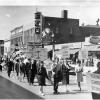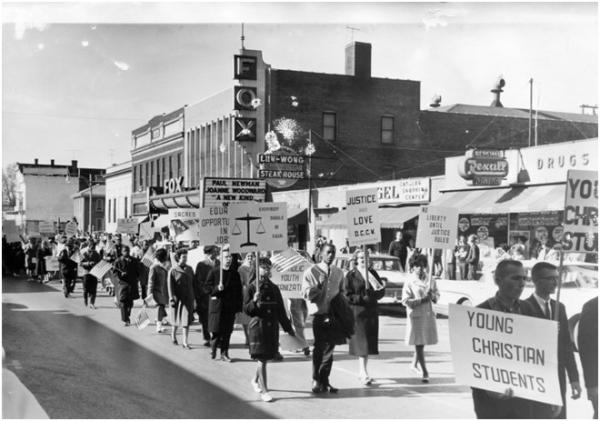The Beginning of the End of Segregation
| Grade | 5th Grade | Class | Length of Lesson | 45 Minutes |
| Lesson Title | The Beginning of the End of Segregation |
| Unit Title | |
| Unit Compelling Question | Why is it impossible for there to be equality when there is segregation based on the color of someone’s skin? |
| Historical Context: The picture used as a historical connection to segregation and Iowa was taken from a protest march on November 2, 1963. This protest was a reminder that Iowa also had problems with segregation that needed to be corrected. The march was created to stress the changes and make Civil Rights legislation more meaningful. To this point in America, people had been fighting to end segregation. 1963 was a turning point year for the end of segregation. In 1963, the fight to end segregation became one of the largest mass movements for racial reform civil rights. In Iowa, 900 people attended this rally with speakers like John Howard Griffin who spoke to the ending of segregation laws in Iowa. |
|
| Lesson Supporting Question | |
| Lesson Overview | In this lesson, students will be working to define segregation and analyze why it became a problem in America. The students will first create their own definition for segregation and discuss it with their classmates. After they create their definition, they will compare it to what the actual definition of segregation is. They will use what they learn about segregation to help them find what is the same and what is difference between their definition and the real one. Students will then read a part of a speech from Senator Thomas Martin’s speech on Civil Rights in 1956. This short reading will be used as a text graffiti where students will write their ideas on the text as well as questions about the text. The students will move their text graffiti to the other students that are in their groups. They will use these to discuss with each other what the speech means for segregation during this time. After the text graffiti, students will observe a picture from a Fort Madison civil rights rally. During this time students will formulate questions about the picture, write any observations, and make any statements connecting this to segregation in Iowa and predict what it was like in our home state. This will propel us into the next lesson where they will be discussing the implications of segregation in America. |
| Primary Sources Used |
|
| Resources Needed | |
| Standard | |
| Lesson Target | The students will analyze multiple sources to pull evidence from in order to answer a compelling question.;The students will evaluate how people’s perspectives during the desegregation of American schools have been shaped based on the social, economic and political atmosphere |
| Lesson Themes | |
|
| Formative Assessment (How will you use the formative assessments to monitor and inform instruction?) |
The biggest way that I will use formative assessments to monitor students and use that information for the next lesson is by listening to what the students discuss. Each group will be discussing the definition of segregation and I can listen to what ideas students come up with in their discussion. I can use this to tell me if I need to reteach the definition in the next lessons. The students will also be discussing the artifact from Senator Thomas Martin as well as the picture of the protest in Iowa during Civil Rights movements. These discussions will help me get a better understanding of what my students understand about segregation and the implications that this had on people during this time. |
| Summative Assessment (How does the lesson connect to planned summative assessment(s)?) |
This lesson uses a couple assessments that can eventually lead to a summative assessment. By reading sticky notes from students, text graffiti, and the posters they create as groups, I can get an understanding of what information needs to be put on the end of the unit summative assessments. The sticky notes will give me an idea of what I need to reteach during the unit as well as how students will perform on a summative assessment. On a summative assessment will be what segregation is and how it impacted people back during Civil Rights movements. The students were given the definition during this lesson as well as some examples of how it impacted people during this time. |
| Author | Reade Reiter | Created | Last Edited | ||||
| Reviewer: Dr. Chad Timm, Simpson College | |||||||
| Lesson Plan Development Notes: Social Studies Methods, Simpson College, Spring 2020 | |||||||


